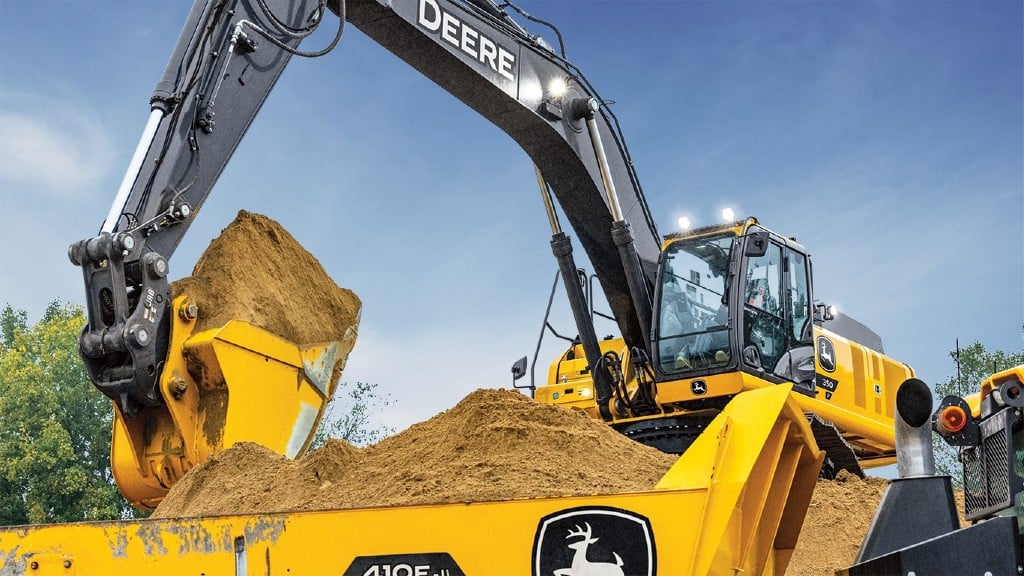John Deere adds pair of excavators to Performance Tiering offerings

The way in which John Deere labels and sells its equipment saw the beginning of a big change in 2021 with the introduction of the company's Performance Tiering strategy. Wheel loaders were the launch platform for the new approach, and now a year later the first excavators to fall into the performance tiering system have been introduced.
Deere has launched two excavators, the 350 and 380, as part of the P-tier, one of three options that customers can consider when buying a new machine. Newly updated and enhanced, the two machines are the first of several that will be introduced in the near future. It's the start of what will be a long transition for both the excavators and other machines, according to Justin Steger, John Deere solutions marketing manager.
"We'll slowly be transitioning other product lines into this tiering structure; excavators is the second product line," he said. "We've transitioned our 350 and 380; the 470 is next, followed by the 670 and 680, and we'll build the portfolio with all of our current lineup . . . probably by the next CONEXPO. It will be a long transition, and other products will be transitioning within that time frame too."
The performance tiering strategy provides buyers with a trio of machine levels to select from: the G-, P-, and X-tiers. Each tier is defined by the way in which the machines are outfitted, with performance and technology increasing with each upward step. G-tier machines are economical and lower priced, but won't have all the features of the P-tier, which is modelled off the previous G series of excavators.
"The majority of models are really falling into that P-tier. The G-tier is really driven around economy and value. It's reliable and has what it takes to get the job done every day, but it comes at a lower price point," Steger explained. "That's naturally going to include a few less options or features, but it will get the same focus from Deere dealers, the same warranty."
The P-tier - currently the only tier available in the excavator line - acts as somewhat of a base model with all key features and performance choices, while customers who want top-of-the-line innovation can look at the X-tier as their best option when they are added to the lineup later on.
"Everything builds on itself - you can think of the G as being rugged and reliable, the P being the exceptional performer, and the X being that leading-edge technology and innovation," Steger said. "It's that next step forward that takes a lot of time to develop - what does it take to move the product line to that next level?"
As new features are developed and added, Deere will decide whether the advance is strong enough to be put into the X-tier, or if it fits in the P-tier range, Steger said. That strategy has worked well in the wheel loader range thus far, and customers have found multiple price points to be helpful.
Lighting package adds visibility and safety
For the newly launched P-tier excavators, the focus has been new updates and advances in a number of areas. Lighting and visibility is one significant update, Steger noted; a new camera package will be standard on several models and optional on others, while lighting is being improved with a full shift to LED lights across the board that allows owners to work any time of day or night safely.
"We're going LED standard across the board, but when you add the camera system or get a machine where it comes standard, it's going to have additional LED surround lighting, one on each side and one in the back. That allows the camera to provide vision to the operator as well as lighting up the surroundings," Steger said. "Whether you're using the camera in the main monitor or not, you'll have a better field of view."
Updated machines also come with new front joint durability, Steger said. Improvements to the boom foot bushings, where the boom connects to the upper structure, provide greater joint life, while the arm tip point where the arm connects to the bucket has also been updated, and central lubrication has been added.
"There are two grease zerks right on the tip of the arm - that's how you grease that arm-to-bucket joint. It actually pushes grease into the centre of the joint and then, as it fills that cylinder cavity, the grease pushes out so any contaminants that work their way into the pivot pin will be pushed out again, extending the life of those joints," Steger described.
The economics of these joint changes are significant - Steger said that customers have two choices to improve their bottom line, either increase productivity or lower cost, and more durable joints do the latter.
Some models are moving away from hydraulically operated fans and introducing electric fans, which bring several benefits, Steger said.
"It's going to improve your fuel economy - if I take a 350 P, running at the same power level as a 350 G [Series], by way of these electronic fans we're reducing the parasitic load on the engine to drive the hydraulics to cool what it needs to cool, and these fans are going to give us up to 7 percent better fuel economy than the previous G series," he explained. In addition, the electric fans are easier to remove and replace if necessary.
Deere's SmartGrade system is available as a factory option and field upgrade, Steger said. The grade management system is flexible right from the factory, allowing customers to choose 2D guidance, 2D control, 3D guidance, or full 3D control depending on their needs. As their business expands, they will be able to upgrade their SmartGrade system along with it, Steger noted.
The 350 and 380 are available now, with more models to follow this summer and fall.



